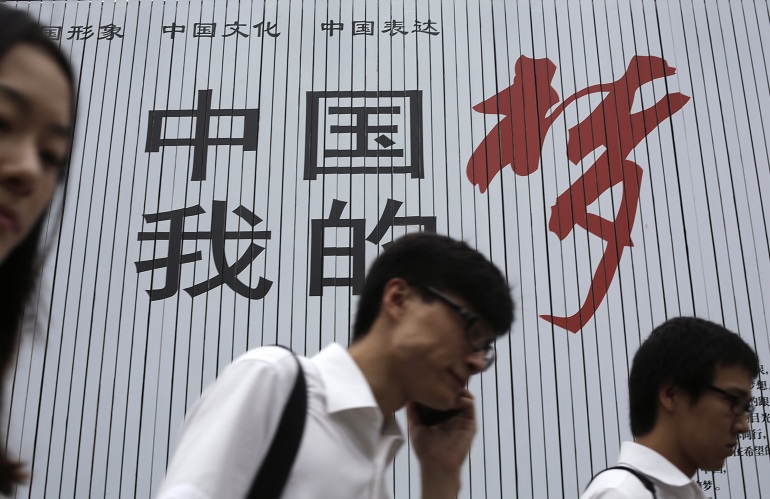What's behind China's debt spiral?

Businessmen walk past the local government's slogan in Chinese reading: "China My Dream" in Shanghai, China. (AP Photo/Eugene Hoshiko, File)
China has made little progress in curbing its worsening local government debt problem in the three years since auditors revealed a worrying picture of the country’s addiction to debt.
The collective debt of local governments increased 3.9 trillion yuan ($720 billion) to 10.6 trillion yuan within a short space of less than three years. The debt has grown about 20 per cent every year for the last three years, far outpacing the country’s GDP growth.
The audit results show government regulators have failed to rein in local government debt despite strong rhetoric to crack down on the runaway problem (Paper tiger: China's potential debt disaster, January 7).
Much has been said and written about local government officials’ voracious appetite for construction, including about the now infamous ghost cities. The 4 trillion yuan stimulus package – which was largely credited with saving Australia from a recession during the global financial crisis – is one of the key contributors to the recent skyrocketing growth.
However, what is not often mentioned is the role of China’s unbalanced fiscal policy in triggering the country’s debt spiral. This is crucial to understand the country’s debt problem.
The problem can be traced back to 1993, when Beijing implemented a momentous new tax sharing agreement with local governments. Before the new agreement, China had a tax sharing agreement between Beijing and local governments that was similar to France’s tax farming system under the ancien régime.
Under that system in France, the King outsourced revenue collection to tax farmers, who agreed to pay a fixed sum to the royal Treasury stipulated in their agreement. Similarly, Chinese provinces agreed to hand over a certain amount of money to central government coffers but were allowed to keep a significant portion of their revenues.
So China’s fiscal situation in the 1980s and early 1990s was exactly the reverse of the situation today. Local government was in a strong fiscal position, while the central government oscillated between fiscal crises.
In a bid to end centralised power, Beijing pushed through major fiscal reforms in 1993, which saw rapid consolidation of revenue collection power under the central government. Beijing won back the rights to retain most of the lucrative revenue streams such as custom duties, consumption and corporate taxes.
As part of the tit-for-tat bargaining, then Premier Zhu Rongji let local government keep the revenues on land sales. This sowed the seeds for their heavy dependence on the real estate industry to finance their fiscal profligacy.
The results were immediate – Beijing’s revenue collection doubled in one year and the central government’s share of the country’s total tax receipts increased from 22 per cent to 56 per cent. At the same, its share of fiscal expenditure increased only two per cent.
The 1993 tax sharing agreement was a major turning point in modern Chinese economic history and it is also crucial to understanding China’s local debt problem. When Zhu – the economic Tsar who implemented the far-reaching fiscal reform – retired in 2004, the central governments’ share of tax revenue was 52 per cent, while only taking up 30 per cent of expenditure.
One of the key advocates for the tax sharing plan, Wu Jinglian, has heavily criticised the implementation of the policy, saying the imbalance between revenue and expenditure is harming the health of the economy.
A decade after the introduction of the tax sharing agreement, local government revenue only accounted for 45 per cent of the country’s tax receipts, but it was responsible for 72 per cent of expenditure in the country. For example, the education budget of local governments is 17 times the size of the central government’s, which has far superior financial firepower, according to Wu Xiaobo’s book on Chinese economic history.
Local government must also bear most of the responsibility for social security spending. Its spending is seven times larger than Beijing’s. As a result, local government needs to turn to debt to finance its ever heavier responsibility for education, social security and environmental protection.
The country’s national audit office calculates that about 87 per cent of local government debt has been spent on infrastructure, public housing, education and other social welfare programs. The imbalance between the central and local governments’ fiscal revenue and expenditure is one of the key contributing factors to the country’s worsening debt problem.
Ryan Rutkowski from the Petersen Institute for International Economics – one of the most influential economics think tanks in the US – argues that “tax and budget reforms are needed to reduce the financial burden of sub national governments.”
In December last year, the central Economic Work Conference stated that controlling local government debts was one of the key work items for this year. One of the toughest challenges is to address the imbalance in China’s current tax sharing agreement.
This is part two of Business Spectator’s series on China's debt problem. The first part of the series can be found here.
Follow Peter Cai on Twitter: @peteryuancai
Subscribe to the China Spectator newsletter: http://bit.ly/ChinaSpec













